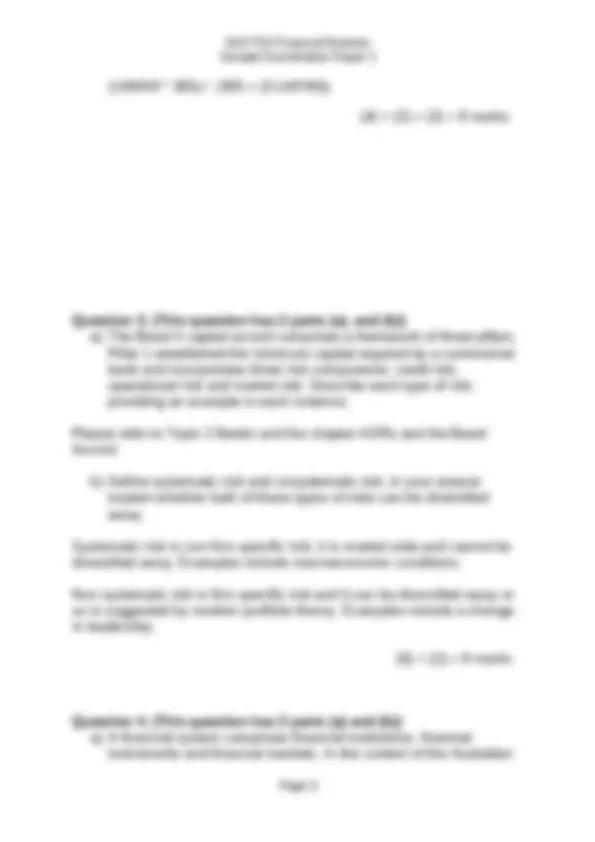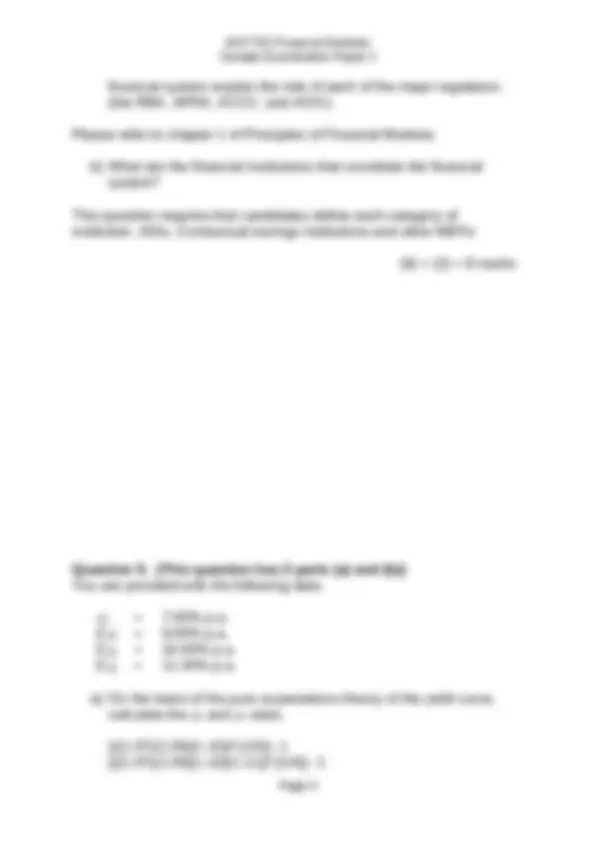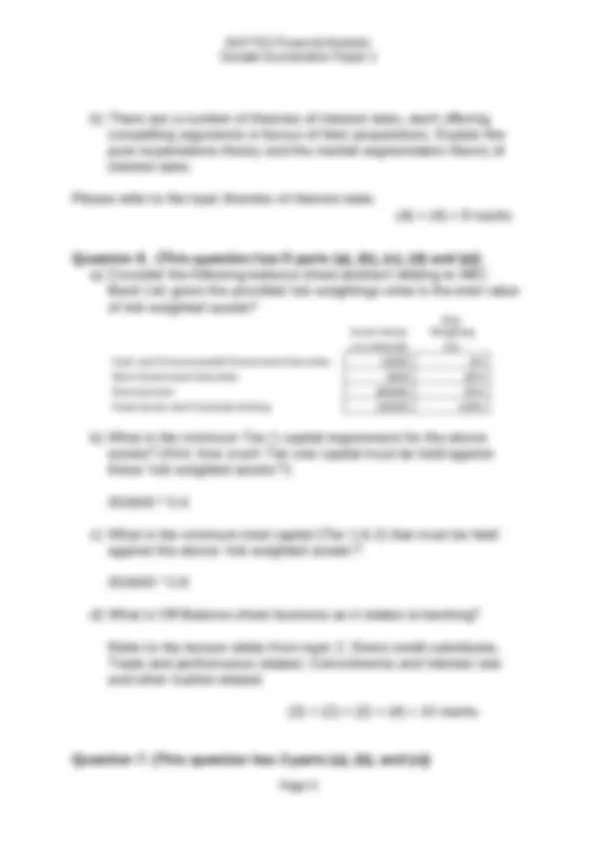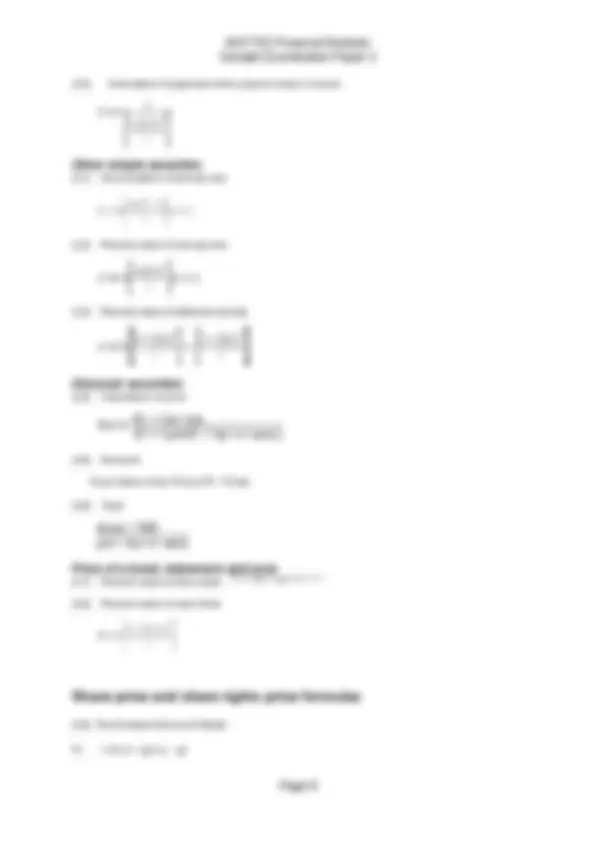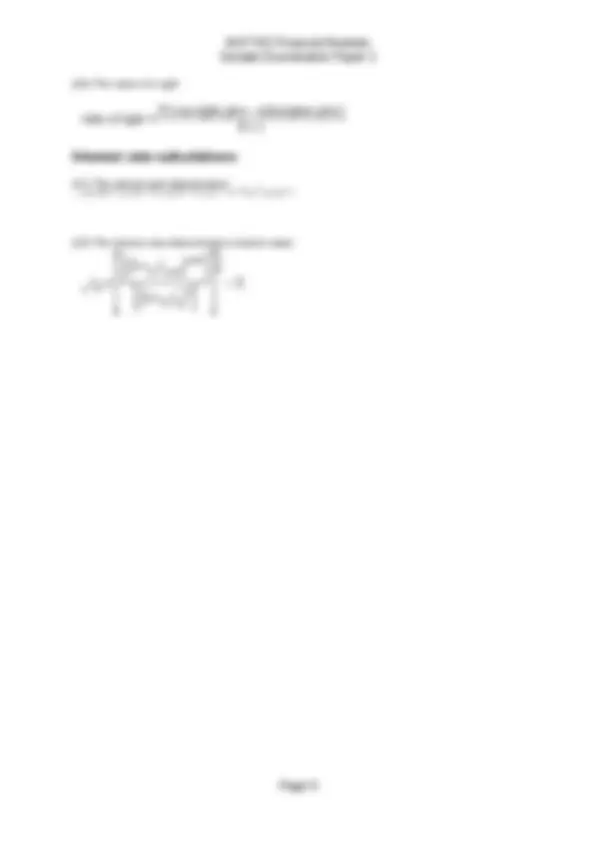Download EXAMINATION PAPER FACULTY OF BUSINESS AND LAW School of Accounting, Economics and Finance and more Exams Finance in PDF only on Docsity!
DEAKIN UNIVERSITY
EXAMINATION PAPER
FACULTY OF BUSINESS AND LAW
School of Accounting, Economics and Finance
SAMPLE PAPER 2
Unit Code: MAF
Unit Name: Financial Markets
Writing Time: Two (2) hours
Reading Time: Fifteen (15) minutes
This examination is CLOSED BOOK.
A sheet of selected formulae is provided at the end of this
paper
Instructions for Candidates:
1. This paper carries 60 marks and represents 60% of your
total assessment for this unit.
2. This paper is made up of seven questions
3. Students must answer all questions.
4. Formula sheets are included on the final three pages of the
paper.
THIS PAPER MUST REMAIN IN THE EXAMINATION ROOM.
Materials authorised for this examination must be in
accordance with Deakin University policy.
Sample Examination Paper 2
Question 1. (This question has 4 parts (a), (b), (c), and (d))
a) Calculate the monthly instalment amount for a mortgage of
$500,000 over 24 years at a rate of 7.80% per annum, payable at
the end of each month (Hint: the last instalment will pay off the
mortgage).
500000/ ((1-(1+i^-n))/i) = PMT
b) How much interest is paid over the life of the loan?
(PMT * 24 * 12) - 500000
c) What is the distinction between recourse based and non-recourse
based lending? What role did non-recourse lending play in the
Subprime Mortgage crisis?
Recourse lending involves borrowing where the lender has recourses
agansit the borrower beyond the value of the asset.
Non Recourse lending involves lending where the lender has no legal
recourse beyond the mortgage asset.
(3) + (2) + (3) = 8 marks
Question 2. (This question has 3 parts (a), (b), and (c))
a) Describe a Bank accepted bill, and explain the role of the
Acceptor, Payee, Drawer and Discounter(s), in the context of Bank
Accepted bills.
Please refer to the topic Short term debt instruments
b) What is the price of a 180 day Bank Accepted Bill with a face value
of $100,000, issued at a rate of 11.5% per annum, with 90 days
left to maturity?
c) If market yields on comparable instruments changed after 10 days,
rising to 14.5%, what impact would that have on the price of the
instrument?
Sample Examination Paper 2
financial system explain the role of each of the major regulators
(the RBA, APRA, ACCC, and ASIC).
Please refer to chapter 1 of Principles of Financial Markets
b) What are the financial institutions that constitute the financial
system?
This question requires that candidates define each category of
institution. ADIs, Contractual savings institutions and other NBFIs
(6) + (2) = 8 marks
Question 5. (This question has 2 parts (a) and (b))
You are provided with the following data:
0 i 1 =^ 7.00% p.a.
E 1 i 1 = 9.00% p.a.
E 2 i 1 = 10.00% p.a.
E 3 i 1 = 11.00% p.a.
a) On the basis of the pure expectations theory of the yield curve,
calculate the 0 i 3 and 0 i 4 rates.
(((1.07)(1.09)(1.10))^(1/3)) -
(((1.07)(1.09)(1.10)(1.11))^(1/4)) -
Sample Examination Paper 2
b) There are a number of theories of interest rates, each offering
compelling arguments in favour of their propositions. Explain the
pure expectations theory and the market segmentation theory of
interest rates.
Please refer to the topic theories of interest rates.
(4) + (4) = 8 marks
Question 6. (This question has 5 parts (a), (b), (c), (d) and (e))
a) Consider the following balance sheet abstract relating to ABC
Bank Ltd; given the provided risk weightings what is the total value
of risk weighted assets?
Asset Values Risk Weighting (in millions$) (%) Cash and Commonwealth Government Securities 20000 0% Semi Government Securities 8000 20% Housing loans 400000 50% Fixed assets and Corporate lending 100000 100%
b) What is the minimum Tier 1 capital requirement for the above
assets? (Hint: how much Tier one capital must be held against
these ‘risk weighted assets’?)
c) What is the minimum total capital (Tier 1 & 2) that must be held
against the above ‘risk weighted assets’?
d) What is Off Balance sheet business as it relates to banking?
Refer to the lecture slides from topic 2. Direct credit substitutes,
Trade and performance related, Commitments and Interest rate
and other market related.
(2) + (2) + (2) + (4) = 10 marks
Question 7. (This question has 3 parts (a), (b), and (c))
Sample Examination Paper 2
Formulae
Simple interest (1) Calculation of simple interest I = Prt (2) Accumulation of principal at simple interest S = P ( 1 + rt ) (3) Present value at simple interest P = S ( 1 + rt )−^1 or P =
S
( 1 + rt ) Compound interest (4) Accumulation of principal at multiple compound interest
S = P ( 1 + i )
n or S = P ( 1 +
j
m ) mn (5) Present value at compound interest P = S ( 1 + i )− n^ or P =
S
( 1 + i ) n (6) Effective annual interest rate in terms of periodic rate ie = (^) ( 1 +
j
m ) m
Ordinary simple annuities (7) Accumulation of n payments of R at i S = R [ ( 1 + i ) n^ − 1 i ] (8) Present value of n payments of R at i A = R [ 1 − ( 1 + i )− n i ] (9) Calculations of payment when accumulation is known R = S [ ( 1 + i ) n^ − 1 i ]
Sample Examination Paper 2 (10) Calculation of payment when present value is known R = A [ 1 −( 1 + i )− n i ] Other simple annuities (11) Accumulation of annuity due S = R [ ( 1 + i ) n^ − 1 i ] ( 1 + i ) (12) Present value of annuity due A = R [ 1 −( 1 + i )− n i ] ( 1 + i ) (13) Present value of deferred annuity A = R [[^ 1 − ( 1 + i )− n i ] − (^) [ 1 − ( 1 + i )− k i ]] Discount securities (14) Calculation of price Price = 365 × face value 365 + ( yield/100 × days to maturity ) (15) Discount Face Value minus Price ( FV - Price) (16) Yield discount ∗ 36500 price ∗ days to maturity Price of a bond, debenture and note (17) Present value of face value P ^ =^ Face^ ^ value^ ^ (^1 ^ + ^ i ) − n (18) Present value of cash flows P = C (^) [ 1 − ( 1 + i )− n i ]
Share price and share rights price formulas
(19) The Dividend Discount Model P 0 = D 0 (1 + g ) / ( rs - g )

